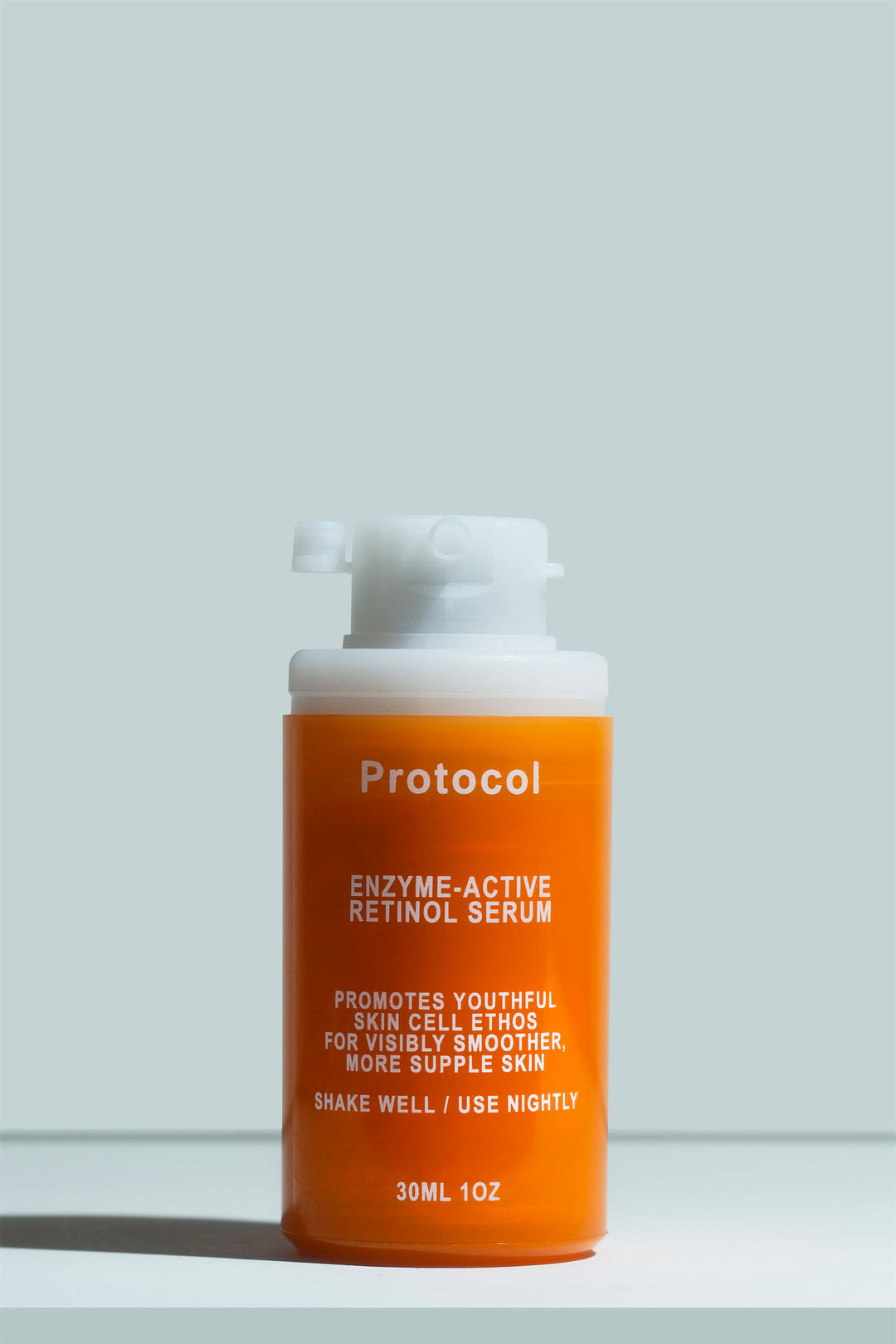Retinol vs. Vitamin C

If we had to pick our two favorite skincare ingredients, retinol and vitamin C would be the obvious answer. They’re the stars of the Protocol product range for a reason! Both are incredibly well-researched, with a multitude of skin-transforming benefits for just about any concern.
Our clients often wonder whether they can be used together, and if so, how. For others, it’s a question of which to invest in, especially if you’re working with limited time or budget.
In this post, we’ll explain everything you need to know about using vitamin C and retinol in your skincare routine!
What retinol and vitamin C are doing in your skincare
Vitamin C and retinol are normally used in skincare to address signs of aging, although that’s only a small aspect of their benefits.
Their affinity for the skin means that they’re able to boost and improve processes that impact all sorts of skin concerns, from breakouts and blemishes to dark spots to the overall texture. And yes, both are also useful for wrinkles!
But they work a little differently, so here's a quick summary of what you should know about each one:
Retinol (aka vitamin A)
Retinoids are actively transformative. They regulate and improve cell proliferation, which results in healthier skin cell reproduction and increased collagen production.
As a result, they’ve been proven to visibly reduce wrinkles, skin texture, and even dark marks. Its most powerful final form, retinoic acid, is commonly prescribed as an acne medication.
If you’ve been following Protocol for a while, you know that we sometimes use retinol as a catch-all term, when in practice, it’s not our favorite retinoid - we much prefer retinal with an “a”.
Once retinol is on your skin, enzymes in your body convert into retinaldehyde (aka retinal) which they then convert into retinoic acid. So using retinal cuts out the middleman, and leads to a product that’s 20% more efficient but isn’t as irritating as using pure retinoic acid (which, by the way, is usually only available by prescription).
Check out our guide to types of retinol for a comprehensive overview of the different retinoids in skincare.
Vitamin C
It’s our running joke that vitamin C is a diva at night but a superhero in the daytime. As a skincare ingredient, vitamin C collects in the skin and raises its antioxidant protection.
During the day, it stops external, damage-causing molecules in their tracks (think pollution, cigarette smoke, and free radicals from UV rays). It even gives sunscreens a bit of a stabilizing boost!
Plus, research shows that it can also actively improve the appearance of the skin, helping to reduce wrinkles and visibly fading dark spots.
So why do we also call it a diva? Vitamin C is only stable and effective in its pure, natural form as ascorbic acid (sometimes listed in ingredient lists as l-ascorbic acid). In that form, it needs a very specific pH level, and any exposure to sunlight or air will start degrading it.
Okay, to be fair, that final issue also applies to retinol. That’s why we package both ingredients in truly oxygen-free packaging we developed with the help of aerospace technology.
Benefits of using both vitamin C and retinol
Retinol and vitamin C are both incredible ingredients, but more importantly, they work beautifully together.
They’re both anti-aging agents, and there’s some overlap in their benefits, especially when it comes to signs of aging. That said, they work differently, so having both in your routine compounds their beneficial effects.
Vitamin C is the stronger antioxidant, while retinol is the more powerful skin renewer. Retinol’s benefits can take a lot longer to show up, but the eventual results are more notable, especially when it comes to fine lines and skin texture.
Plus, once you’ve used vitamin C for a few days in a row, it collects in your skin, so you get a very long-lasting boost of antioxidant protection. By using vitamin C during the day, you help protect and stabilize the retinol product you use at night, preventing its degradation and ensuring you get better results.
How to use retinol and vitamin C together
For the best results, use vitamin C serum in the morning and retinol at night.
What does that look like in practice?When you wake up in the morning, wash your face or just splash it with water. The more water, the better! While it’s still damp, gently massage or press the vitamin C into the skin. Let it absorb completely (this can take a few minutes), and follow it up with sunscreen.
If you use any other leave-on skincare products, apply them after the vitamin C serum and before the sunscreen.
Then, at night, it’s pretty much the same process! Wash your face (and if you can, try to really soak it with water, like in the shower). While it’s still damp, apply your retinol serum. Let it sink in completely, and for even better results, wait a full 30 minutes. Then, finish off with the rest of your skincare routine.
Check out our guide to skincare routine steps if you’d like to build a full regimen that includes both vitamin C and retinol.
Note: This doesn’t apply to prescription retinoids, which can be a little irritating to the skin. With those, many dermatologists recommend applying them on top of moisturizer in order to slow their rate of penetration and reduce chances of irritation. This isn’t normally an issue with cosmetic retinoids like our Enzyme-Active Retinol Serum.
Which is better, retinol or vitamin C?
We need to be honest here - the Protocol Lab Team has a favorite child.
Both retinol and vitamin C are extremely beneficial to the skin, but between the two, we think retinol is the more impressive ingredient thanks to its powerful abilities (at least in its bioactive form as retinaldehyde).
That’s because retinol makes a bigger difference over time. If you’re in it for the long haul to prevent and reverse signs of aging, there is no ingredient with better cred.
That said, in the short term, many of our clients find that vitamin C gives their skin an immediate glow and vibrance. If you want to improve the appearance of your skin quickly, like before a special event, it’s the best ingredient to rely on.
FAQ
Do I use vitamin C or retinol first?
We don’t recommend using vitamin C and retinol at the same time. The first ingredient that goes on your skin will have the biggest impact, and frankly, both vitamin C and retinol deserve to be used to their utmost potential.
Plus, vitamin C fits beautifully into a daytime routine while giving your sunscreen some added stability, while retinol is going to do the most for your skin at night, away from the degrading effects of the sun.
It’s also possible that using two such potent ingredients in a row will increase your chances of skin irritation, although this depends on your skin and on the specific products.
How long should I wait between vitamin C and retinol?
If you’re intent on layering vitamin C and retinol one after the other, give the first ingredient enough time to totally sink into the skin. Only apply the next product once there’s zero noticeable residue on the surface.
For even better results, give it a full 30 minutes before applying your next active. For best results, split them up - vitamin C in the morning, and retinol at night.
Unleash the Super Duo!
So to summarize: Can you use vitamin C and retinol together? Yes, especially if you use the latter at night and the former in the daytime! Should you? Absolutely - the two ingredients support each other and lead to better results.
And what if you only have to pick one? It depends on your goals, but between the two, we think retinol is the long-term heavy hitter that leads to the biggest transformation.
Want to discover their combined power on your own skin? Give our Mini Molecular Super Duo a try. Includes a 30-day supply of both ingredients stabilized in their most potent, active forms.




